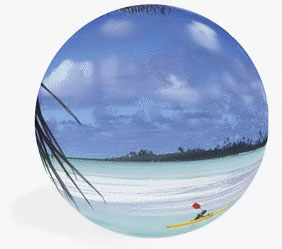 Spherical panoramas are usually represented in equi-rectangular, cubic or semi-spherical format. True spherical image formats represent 360 degrees horizontally and180 degrees vertically. A viewer can therefore turn a complete circle, and look directly up and down in an unlimited fashion. Such images are intended to be viewed as though they are projected onto the interior of a sphere. In the case of semi-spherical panoramas vertical field of view is limited. Another unusual format is generally known as the Little Planet because it remaps an equi-rectangular panorama onto a full-circle fish-eye image with the point directly below the photographer at the centre and the zenith at the outer edge of the circle.
Spherical panoramas are usually represented in equi-rectangular, cubic or semi-spherical format. True spherical image formats represent 360 degrees horizontally and180 degrees vertically. A viewer can therefore turn a complete circle, and look directly up and down in an unlimited fashion. Such images are intended to be viewed as though they are projected onto the interior of a sphere. In the case of semi-spherical panoramas vertical field of view is limited. Another unusual format is generally known as the Little Planet because it remaps an equi-rectangular panorama onto a full-circle fish-eye image with the point directly below the photographer at the centre and the zenith at the outer edge of the circle.
Spherical images reveal curves in horizontal lines when the panorama is viewed flat. Panoramas of the equi-rectangular format are the most efficient in terms of field of view, but cylindrical panoramas are generally more acceptable when printed. Any panoramic image can be presented in spherical form but, if the image is less than a full 360 degrees in width and 180 degrees in height, its actual dimensions must be declared to the presentation system. Areas of the full spherical image which have not been recorded can then be padded with blank pixels.
Full spherical panoramas are challenging in a number of respects. Their success is dependent upon finding suitable subjects which provide sufficient all-round interest, and they are difficult to view conveniently. They also tend to be limited in resolution because the amount of information involved with high resolution images makes the necessary processing slow. However, interactive software is available which presents viewers with the part of the spherical panorama in front of their eyes, and allows the image to be explored by panning and tilting in any direction.
Note that the image is for illustrative purposes only. Just imagine that you are positioned at the centre of the sphere and looking around at its inner surface!.